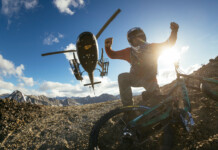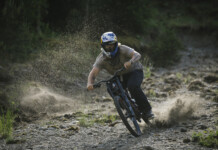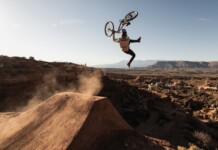By John Shafer – The 11th Red Bull Rampage was held in mid-October in Southern Utah, near Zion National Park. For anyone who doesn’t know what Red Bull Rampage is, it’s a one of a kind, invite-only mountain bike freeride competition featuring huge jumps, massive drops and sketchy billy-goat lines – all on super-exposed Southern Utah cliffs. Most people think it’s just plain insane. Even if you don’t know it by name, you’ve probably seen some viral videos on Facebook or YouTube. With the best freeriders in the world going all-out in the fantastic Southern Utah landscape, there’s no other mountain bike event that even comes close to matching the spectacle and drama of Red Bull Rampage.
[Editor’s note: this article originally appeared in the Winter 2016/2017 issue of Cycling Utah. References to dates and timeframes should keep that in mind. With the 14th Annual Red Bull Rampage coming up on October 25, 2019, we felt it was a good time to repost.]
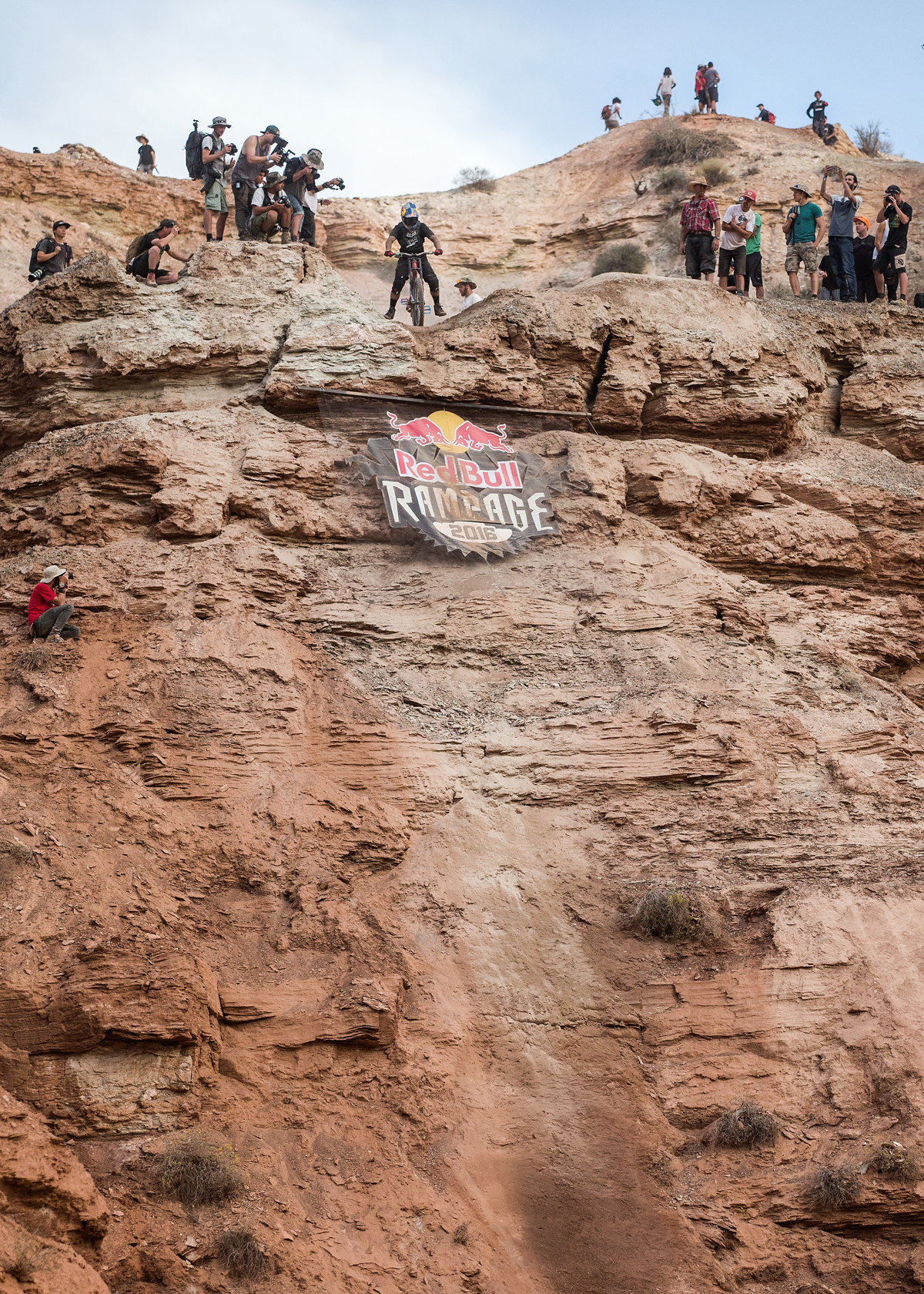
If you’re expecting a ride-by-ride report – this isn’t it. The real intent of this article is to talk about whether or not Rampage riders are as crazy as people think they are. I’ll also detail some of the new format changes made to address all the controversy that followed Red Bull Rampage, last year. Don’t worry, though – we won’t completely ignore the riding (or crashing). Toward the end of the article there’s a section with some highlights and descriptions of the winning runs. But if you really just want to know who won and what kind of tricks and carnage occurred, that stuff is all over the web. I recommend going straight to the Red Bull Rampage web page and checking out the videos of the winners. That’s a much better way to experience Rampage than reading some hack writers report.
Are Red Bull Rampage Competitors Crazy?
According to most social media headlines and viral video comments, Red Bull Rampage competitors are completely nuts – suicidal, even. That’s a totally understandable reaction. It couldn’t be further from the truth, though. If all you’ve seen are a few photos and a couple of videos, you only know a tiny bit of the story. As a long-time Rampage attendee (I’ve been attending as a photographer since 2002) who even calls a few ex-competitors friends, I have a very different view of the event. I’ve watched the athletes, the lines and the event coverage evolve from rough and scrappy to polished and mass market. I’ve spent days at each event watching the riders scout, sculpt and practice their lines and I know how much hard work and analysis happens before each rider drops in for the final run you watch on your computer or TV.
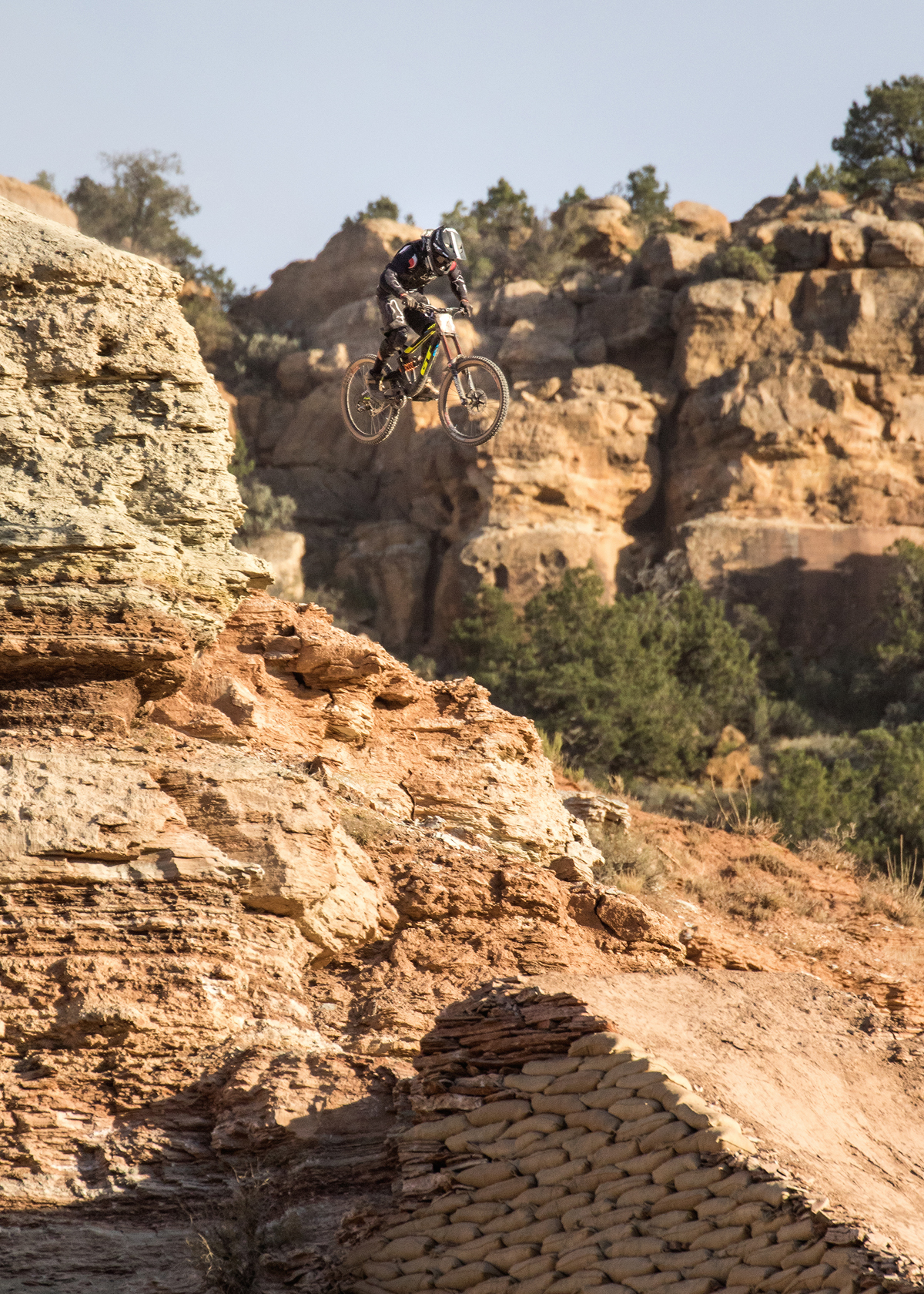
Red Bull Rampage is high-risk – there’s no denying that. That’s part of what makes it such a great spectator event. But the competitors are anything but reckless. They’re supremely fit, experienced and very calculating. After reading comments on photos I shared on Instagram and Facebook during this year’s Rampage, I realized most people have no idea what’s really involved. So I posted a photo of 2014 winner Andreu Lacondeguy, stopping at the top of a huge drop (see photo, below) toward the end of Wednesday’s practice session. Andreu rolled up on this drop for over an hour, stopping each time right at the brink. It was pretty scary to watch. He’d drop in from above, get up to speed and stop at the last fraction of a second. Then he’d get off the bike and stare over the edge. Sometimes he’d toss a rock over and watch it fall. Once, he grabbed a shovel, climbed down the cliff to the landing zone and smoothed out a bit he wasn’t happy with.
This kind of behind-the-scenes action is something you only witness if you’re there for a few days. In fact, if you’re on-site while they build and practice, you watch it over and over again, with every rider. Nobody just builds a line and sends it. That would be suicidal. There’s no doubt competitors are nervous about the bigger drops and stunts – they should be. There can be life-changing consequences if things go wrong – the chance of serious injury or even death when you’re 30 feet above the ground is very real. The one Utah competitor, St. George local and 2012 third place finisher Logan Binggeli, crashed on a huge drop during Thursday’s practice and missed the finals due to a concussion.
My point here isn’t actually about fear or consequences, though – it’s about data collection. Red Bull Rampage competitors aren’t crazy – they’re scientists. I don’t think that’s hyperbole, either. I mean it quite literally. The reason Rampage looks crazy to the average person is they have no comprehension of what it takes to be able to ride this stuff with confidence and control. It takes tons of experience and experience is data. Everything the Rampage riders do before they drop in for their final run is data collection. Every practice run is a speed test. Every time they stop and look over a cliff or toss a rock down to a landing, they’re estimating how much speed and what angle of entry they need to safely land. You don’t just show up in Virgin and huck your meat off a cliff. Every rider comes to the event with years of freeride mountain bike experience, which they apply to the new, bigger problems Rampage presents.
When Andreu Lacondeguy finally did hit that drop – about twenty minutes after the sun had set – he landed it perfectly and everyone cheered.
Format Changes
To say there was a huge amount of controversy following last year’s Rampage would be an understatement. After Paul Basagoitia was paralyzed crashing on a huge stepdown, fears and concerns that had publicly gone unspoken for years exploded to the surface. It seemed like every magazine and web site ran some sort of article about risk, athlete compensation and Red Bull responsibility and accountability. Red Bull took a lot of heat and to their credit they made a bunch of changes to try to make the event safer.
The most obvious difference this year was a new location, which turned out to be just the next mesa over – only a few hundred yards to the east of last year’s Rampage site. At first, the new site didn’t appear to me to be that different or special – in fact, to my eye it looked almost the same as the 2013 site. I did notice the huge canyon gaps and big wooden structures of the past few years were missing. With the exception of some sandbag fortifications, everything was cut and built from natural materials found on-site. It turns out one of the changes this year was a limit on construction. Aside from shovels and a limited number of sandbags, no other tools or building materials were permitted and each competitor was allowed just two diggers to help build their line.
The main intent of the Rampage format changes was to make the event safer. To that end, the number of athletes was limited to 21 – the top 12 riders from last year’s competition plus 9 wild card riders. There was no qualifying – just building, practicing and two final runs per rider on Friday. To make sure everyone was fresh, a mandatory rest day was added between the four-day build period and the official start of practice, on Wednesday. To address complaints about unfair results in previous Rampages, this year’s judges were all past competitors.
It’s hard to say whether the changes actually made this year’s Rampage safer. The lack of huge manmade wooden structures made it appear that way. But the new site looks more exposed and steeper at the top and riders were building some really tight, technical lines that required absolute precision. On the other hand, I did feel athletes were being extra careful and calculated about building and testing their lines. Not that they weren’t careful in the past. But it seemed like it took them longer to get around to guinea-pigging the really big stuff.
2016 Red Bull Rampage Finals & Results
As I said earlier, this article isn’t a play-by-play of the event. If you want to see it all, watching the videos on the Red Bull web site or the full show on Red Bull TV is a better way to do that. I will give you a short overview of the lines, highlights and top finishers, though.
There were three clear line sections off the top of the Rampage site – rider’s left, down the middle of the butte and rider’s right. Competitors were allowed two runs in Friday’s finals and rider order in the finals was left to right. Since riders were only allowed two diggers, the build teams worked together for efficiency and there was a lot of line sharing. Of course, no two riders rode the exact same line. Each competitor built something unique and kept some tricks up their sleeve for Friday’s finals. The building cooperation did ensure there weren’t any complaints about line poaching as there have been in previous years.
The left line was shared by Rampage veteran Darren “Bearclaw” Berrecloth, young gun Carson Storch and Tyler McCaul. The top of that line is ridiculously steep and exposed and it was scary to watch them drop in and billy-goat their way down to the massive “Green Goblin” stepdown gap (see photo, below). After the Green Goblin, they rode an exposed ridge with a couple of big jumps before their lines diverged. All three riders had huge drops after the ridge, after which they dropped into the huge jumps trick jumps at the bottom of the course.
Carson Storch is just 23 and this was his third year at Rampage. He made a big impression at his first Rampage in 2014 with big lines, lots of tricks and a couple of huge crashes that didn’t seem to faze him. This year everything came together for him. He rode the steep, exposed “Impassable Route” on rider’s-left with style, confidence and amplitude. A perfectly-executed 360 stepdown off the ridge got a huge cheer from the crowd and earned him this year’s best trick award. He wrapped up his run with a monster flat 360 on the bottom trick jump to land himself a third place podium spot.
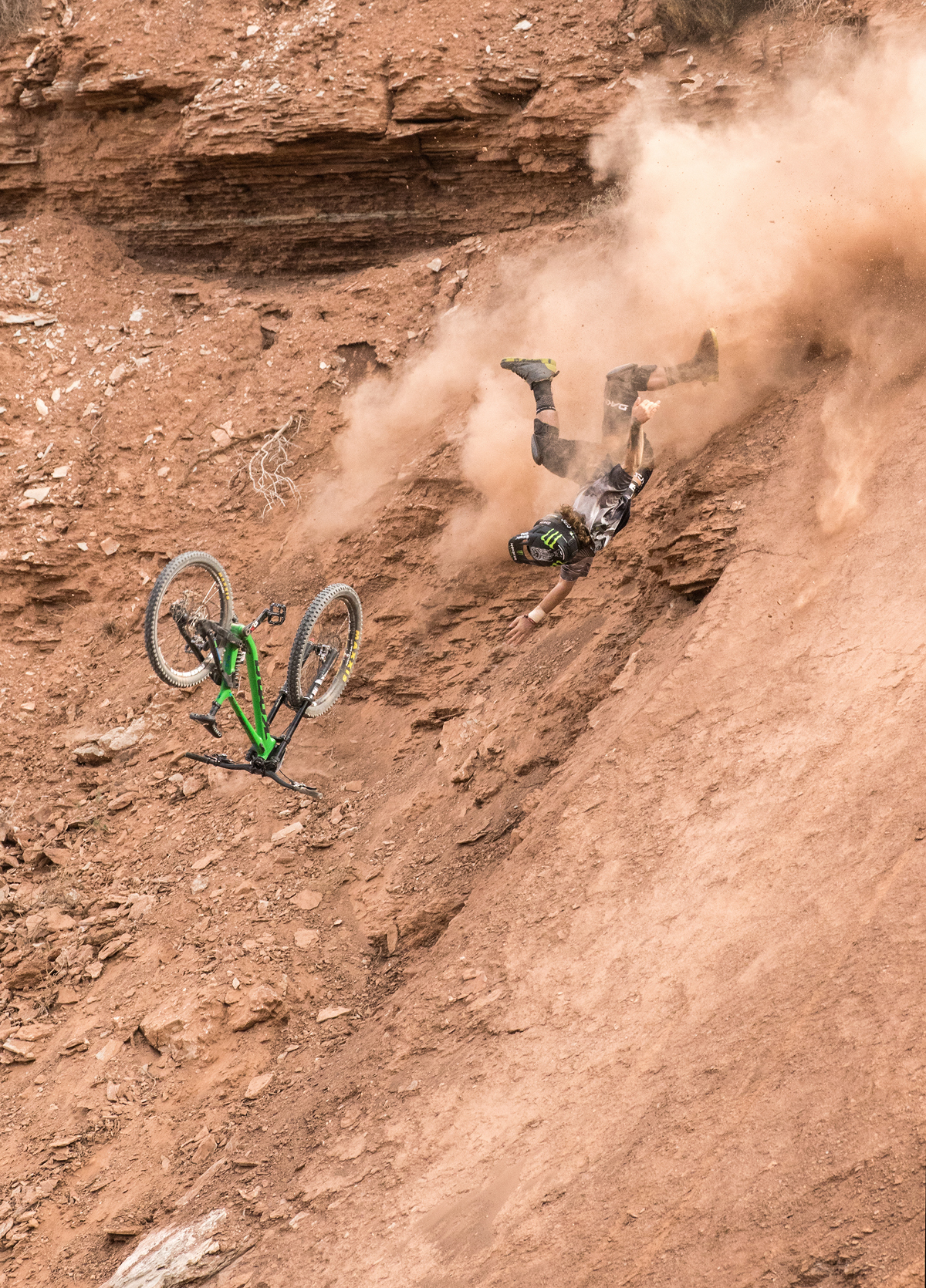
Only two riders, Graham Agassiz and James Doerfling, took the middle line off the top – rolling down the throat of the butte on a straight elevator drop line. It was hard to take pictures that did this section justice but it was one of the most intimidating-looking lines of the competition because it was so steep and fast. Agassiz, a crowd favorite, was having an awesome first run, stomping the top section then going big and fast across the main ridge. But in the middle of his run he 360’d a huge step-down drop and missed his landing. It was, hands-down, the nastiest crash (see photo, below) of the competition – exactly the kind of thing we don’t want to see at Rampage. It was a very scary moment but he was taken away conscious and moving. Apparently he broke his pelvis, which is terrible. But he will have a full recovery. If he’d landed that 360 it probably would have put him on the podium – maybe even the top spot.
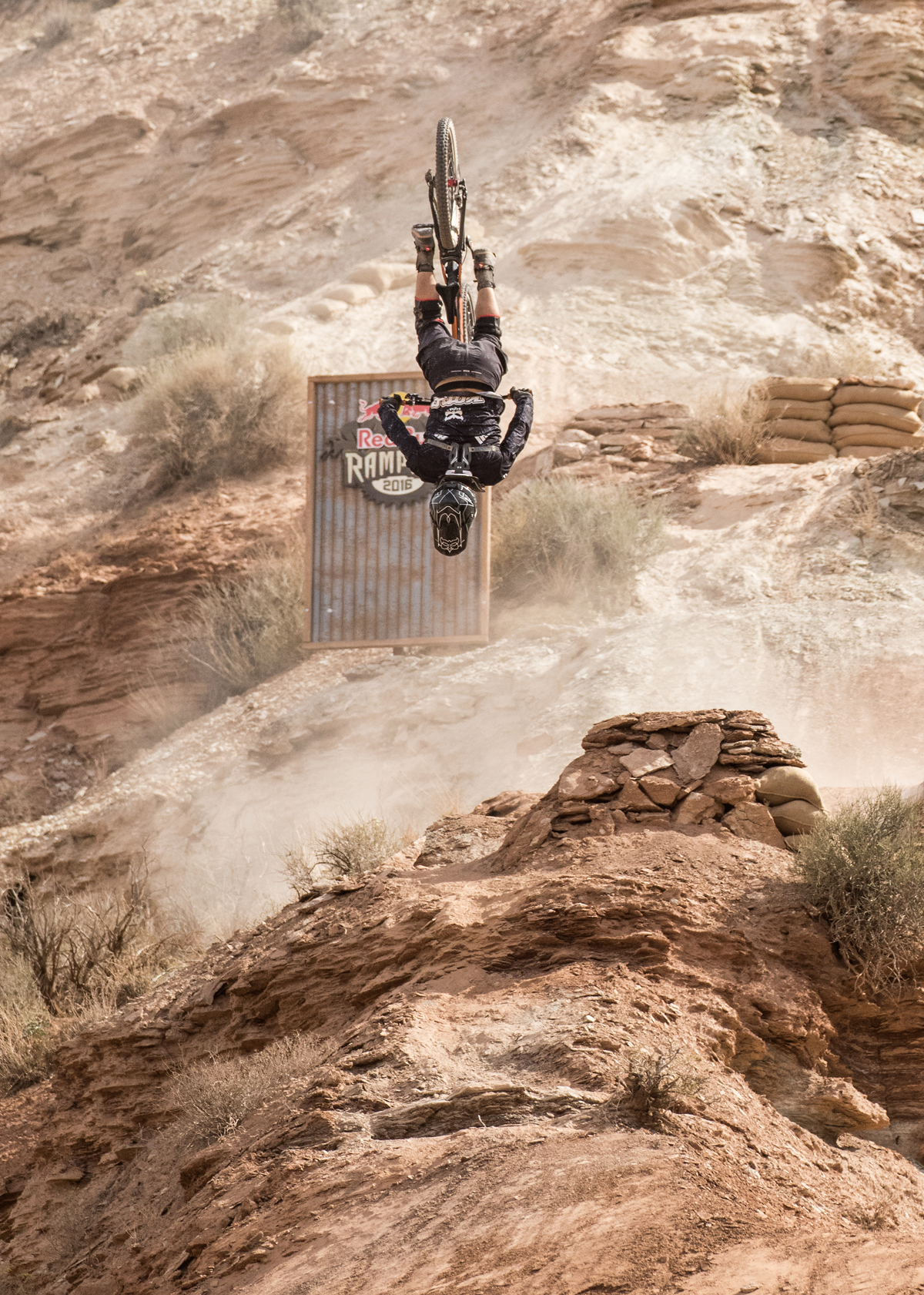
The rest of the competitors started rider’s right with two huge, steep, exposed drops followed by a high ridge that led to two descending ridges with big stepdown jumps. French rider Antoine Bizet rode the first two drops smoothly then dropped to the middle ridgeline where he crushed a big backflip stepdown followed by a huge, fast drop. According to Rampage announcer Cam McCaul, Bizet has wanted to do a double backflip at Rampage for some time; and he had done one in practice. So there was a lot of expectation as he hit the last big drop that sets riders up for the big trick jump at the bottom of the course. And he stomped it – two full rotations for a double backflip – the first ever at Red Bull Rampage. That earned Bizet his second second-place spot at Rampage. He also took second in 2012.
Brandon Semenuk, this year’s winner, also rode the main line, dropping in on rider’s right. Always a fan favorite, Semenuk is a technical slopestyle specialist. But he’s also comfortable on the big, raw Rampage terrain and already had a 2008 win under his belt. So expectations were high as he dropped in. He built his own line off the ridge with a huge, technical double drop (see photo, below). He also tricked nearly every lip he hit, including a flat spin 360 on a step up, a super technical flat backflip off a hip and a huge backflip on the bottom trick jump. It was well-deserved win. He combined lots of speed, control, confidence and a big bag of tricks to join a very small club of two-time Rampage winners.
It wouldn’t be right to forget Conor MacFarlane, the winner of the first Red Bull Rampage Kelly McGarry Spirit Award. Given to the rider that best exemplifies the joyful, positive spirit of everyone’s favorite freerider, Kelly McGarry, Conor was the obvious choice for the award. Not only is he from New Zealand, just like Kelly, but he refused to give in to adversity. Scabby, bloody and bandaged, Conor crashed and crashed and crashed – but he never quit. There’s no doubt Kelly would have approved of giving him the award.
Conclusion
To summarize – Red Bull Rampage is nuts. But the competitors aren’t. It just looks crazy if you have no knowledge of the rider’s skills, care and calculation.
As far as safety goes, I’m not sure this year’s format changes actually made the event safer. It looked to me like there was more exposure and the competitors certainly weren’t being conservative in their line choices. There were a few scary crashes but luckily the worst injury was Graham Agassiz’s broken pelvis. I do think there’s more sensitivity to rider safety, though. Rampage is a super exciting event that’s great for spectators, TV and increasing interest in mountain biking. That’s great, as long as it’s not at the expense of competitors’ bodies or lives.
For more on the Red Bull Rampage, visit redbullrampage.com

